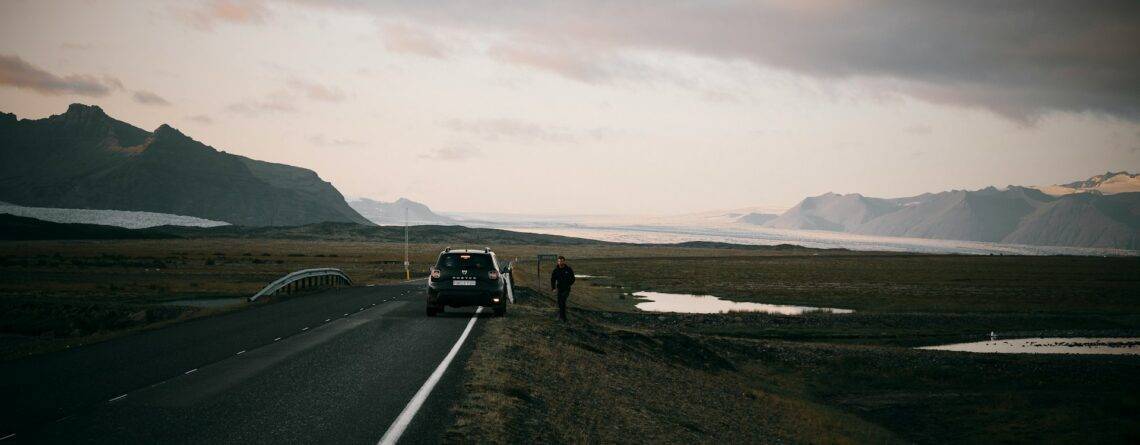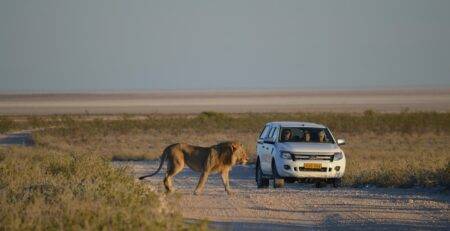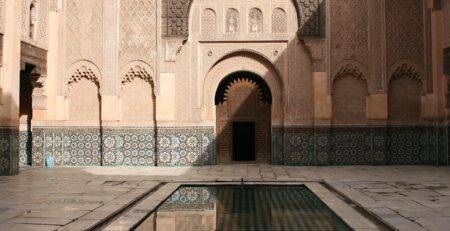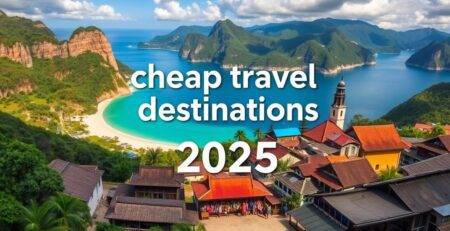As I look ahead to 2025, I’ve been doing some digging into what’s next for how we explore the world. It seems like travel is shifting, moving away from just seeing new places to really experiencing them. From what I’m seeing, people want more meaningful trips, whether that’s connecting with stories from the past, finding calm in quiet places, or even using new tech to plan it all. It’s an exciting time to be thinking about where we’ll go and what we’ll do. Here are some of the top travel trends 2025 that I think everyone should know about.
Key Takeaways
- BookTok and a general desire to unplug are making literary travel more popular, with people visiting places from their favorite books.
- Astrocartography, or using the stars to guide travel, is a growing trend for those seeking personal connection through their journeys.
- The ‘long honeymoon’ is back, with couples extending their post-wedding trips for more immersive experiences.
- Visiting women’s museums and learning about ‘herstory’ is becoming a way to gain new perspectives on historical events.
- Noctourism, focusing on nighttime experiences like aurora viewing, and Calmcations, trips designed for pure tranquility, are gaining traction.
1. Travel Gets Lit

I’ve noticed a real shift lately, and it’s pretty cool. It seems like books are suddenly everywhere, not just on shelves, but as actual travel inspiration. You see celebrities carrying paperbacks like they’re the latest accessory, and honestly, it’s making me want to pick up a book myself. This whole “BookTok” thing on social media is really pushing people to visit places they’ve only read about. It’s one of the top travel trends for 2025 that I’m genuinely excited about.
Bookish Destinations
It’s not just about reading on vacation anymore. People are actually planning trips around literary festivals or visiting places featured in novels. I saw a report that said over 70% of people have been inspired to travel somewhere new just from reading a book. That’s a huge number! Think about visiting the settings of your favorite stories – it’s like stepping right into the pages. I’m personally looking at a trip to a place I read about in a historical fiction novel; it sounds amazing.
Literary Hotels and Experiences
Hotels are getting in on this too. Some historic places are really leaning into their famous writer guests from the past, promoting their literary connections. And new hotels are popping up that are designed with specific authors or literary themes in mind. It feels like a way to connect with something real, something offline, which is what I think a lot of us are craving these days. It’s a different kind of authenticity, you know?
The Rise of Travel Book Clubs
I’ve also heard about travel companies starting book clubs that connect readers with destinations based on the books they read. It’s a neat idea, blending the love of reading with the desire to explore. It makes me wonder if I should start a book club focused on travel literature. It’s definitely one of the more unique popular travel trends 2025 has to offer, and I’m here for it. Maybe I’ll even find some budget-friendly travel destinations for 2025 through it.
2. Astrocartography

Have you ever visited a place and just felt an instant, undeniable connection? Or maybe the opposite – a spot that just felt… off? I know I have. While many of us know our zodiac signs, there’s a growing trend in astrology that goes deeper, suggesting that different locations can actually influence our lives in specific ways. This is the world of astrocartography.
What is Astrocartography?
Astrocartography is essentially the practice of mapping your birth chart onto a world map. The idea is that the planetary positions at the exact moment and place of your birth create energy lines across the globe. Each planet is thought to govern different aspects of life. For instance, traveling along your Venus line is said to bring romance, while a Mars line might make you feel more energized, or perhaps a bit on edge. It’s a fascinating way to think about why certain places might feel more aligned with your personal journey.
Why it Matters in 2025
This practice, pioneered back in the 1970s, is really hitting the mainstream now. A big part of this is how accessible travel has become. You can hop on a plane in one city and be in a completely different continent the next day. Plus, with more people working remotely, the idea of setting up your laptop wherever feels right is really taking hold. But with so many options, choosing where to go can be overwhelming. That’s where astrocartography comes in. Many people are turning to it to help narrow down their choices, not just for vacations, but for places where they might find success in their careers or even meet a significant other. Royal Caribbean, for example, is even launching astrocartography-led holidays in 2025, making it easier for astrology enthusiasts to plan their perfect getaway based on their personal charts.
The appeal lies in finding destinations that feel intuitively aligned with our personal energies and aspirations, turning travel planning from a chore into a quest for self-discovery.
3. The Long Honeymoon

I’ve noticed a big shift in how people approach their honeymoons. Gone are the days when a week on a beach was the standard. Now, couples are really stretching out these post-wedding trips, sometimes calling them ‘mega-moons.’ It seems like with more people working remotely, they can actually take longer trips without using up all their vacation days. Plus, after spending so much on a wedding, some couples are saving up to make the honeymoon a truly epic, once-in-a-lifetime experience.
Why it matters in 2025
This trend is picking up steam because people are prioritizing experiences. Instead of just a quick getaway, newlyweds want to really immerse themselves in a destination. Think extended road trips, learning a new skill together like wine tasting, or just having more time to relax and connect without feeling rushed. It’s about making that special trip last.
Destinations for the Mega-Moon
- Costa Rica: Offers a mix of beaches, forests, and volcanoes, with hotels providing ‘workation’ packages that include personal assistants and outdoor workspaces.
- Ubud, Bali: Known for its villas that come with dedicated workstations and even conference rooms, making it easy to balance work and relaxation.
- Europe: Many couples are opting for longer stays in European cities or countryside estates, blending cultural exploration with remote work.
Making it Work
The idea is to create a truly memorable experience that goes beyond the typical short trip. It’s about having the time and space to enjoy each other and the destination fully, almost like an extended vacation before diving back into everyday life.
This approach allows couples to really disconnect and enjoy their new married life without the pressure of a ticking clock. It’s a chance to create deeper memories and truly savor the beginning of their journey together.
4. Herstory Lessons Through Women’s Museums

I’ve noticed a real shift lately in how people want to travel. It’s not just about seeing famous buildings anymore. There’s a growing interest in understanding history from different viewpoints, and that includes learning about the women who shaped our world but often don’t get the spotlight. This is why I’m excited about the rise of museums dedicated to women’s stories.
These places are offering a fresh look at history, focusing on the contributions of women in everything from art and politics to science and social movements. It feels like a more complete picture of the past is finally coming into focus. It’s about appreciating unfiltered, provocative stories from the sidelines.
Why This Matters in 2025
There’s a strong desire to celebrate women’s narratives. This ties into the increase in solo female travel and families wanting to educate their children about diverse historical figures. We’re seeing new institutions opening, like the East End Women’s Museum in England, which is the first of its kind focused on women’s experiences. Other places are also doing great work, like Chawton House in England, which highlights early female writers, giving credit to authors who were often overlooked. Even places like KØN – Gender Museum in Denmark are exploring the cultural history of gender and women’s rights.
Experiencing Herstory
- Visit dedicated women’s museums: Seek out institutions like the ones mentioned above or explore local museums that might have exhibits focusing on women’s history.
- Explore literary sites: Visit homes or places associated with influential female writers and thinkers.
- Engage with art: Look for museum audio guides or tours that specifically highlight female artists, like the Museums Without Men guides. I found a great resource for magazines in France that touches on how cultural narratives are evolving.
- Support women-led initiatives: Look for tours or experiences curated by women, which often provide unique cultural access.
This trend is about more than just visiting a building; it’s about actively seeking out and engaging with stories that have been marginalized. It’s a way to broaden my own perspective and connect with history on a deeper level.
5. Noctourism

Experiencing Destinations After Dark
I’ve noticed a real shift lately, with more people looking to explore places when the sun goes down. It makes sense, really. Daytime can be a total madhouse, especially at popular spots. Think about trying to see the Acropolis when it’s packed and sweltering – not exactly my idea of fun. But at night? Suddenly, it’s cooler, there are fewer people, and you get a completely different vibe. It’s like seeing a familiar place with new eyes.
This trend, which I’m calling Noctourism, is picking up steam. Companies are reporting more interest in things like night diving in places like the Great Barrier Reef or going on safaris after dark in Africa. Even chasing the Northern Lights is a big part of this. It’s not just about avoiding crowds and heat, though that’s a huge plus. It’s about experiencing something unique, something you can’t get during the day. I read about a tour where you can actually be in a famous cathedral after everyone else has left, and the master locks up for the night. Imagine that quiet, that sense of history all around you. That’s the kind of memory I’m looking for.
- Nighttime wildlife walks: Spotting creatures that only come out after sunset.
- After-hours museum visits: Experiencing cultural sites without the daytime rush.
- Stargazing tours: Connecting with the cosmos in remote, dark-sky locations.
It feels like a natural progression, especially with the planet getting warmer. More and more places are starting to offer these kinds of experiences because travelers are asking for them. I’m definitely planning to incorporate some of these after-dark adventures into my own travels next year. It’s a whole new way to see the world, and I’m here for it. You can find some really interesting nighttime tours that offer a fresh perspective.
6. Calmcations
I’ve noticed a real shift lately, and it’s not just me. People are actively seeking out trips that are all about peace and quiet. It makes sense, right? With all the constant noise from traffic and just, well, life, it’s no wonder we crave a break. I read somewhere that noise pollution is a major health issue in Europe, which really hit home.
Escaping the Noise
Some places are really leaning into this. I saw this company that offers “quiet escapes” along the Norwegian coast. They even have these stations that monitor noise levels and compare them to big cities. Pretty wild, huh? Then there are these tech-free cabins popping up, with a whole mission to help people “switch off.” It feels like getting away from it all now includes getting away from our phones and constant notifications. I’m definitely tempted by the idea of just disconnecting for a bit.
Reconnecting with Nature
It’s not just about silence, though. It’s also about finding places that help you feel grounded. Think off-grid cabins in peaceful settings, places where you can just be outside and breathe. It’s a way to get back to basics, I guess. I’m looking forward to finding a spot that offers this kind of tranquility, maybe somewhere with easy access to nature trails. It seems like the perfect antidote to a busy life, and honestly, I could use one of the cheapest countries to visit in 2025 right about now.
What Travelers Seek:
- Quiet environments, away from city sounds.
- Opportunities for digital detox and reduced screen time.
- Access to nature, like forests or coastlines, for relaxation.
- Experiences that promote mindfulness and a slower pace.
7. Travel Meets AI
I’ve noticed a big shift in how I plan my trips lately, and it’s all thanks to artificial intelligence. It feels like AI is really starting to change the game for travelers, making things smoother and more personalized. It’s one of the most interesting emerging travel trends 2025 has to offer.
AI-Powered Trip Planning
When I look at the latest travel trends 2025, AI-powered planning is definitely at the top. Companies are using generative AI to help build itineraries, which is a huge time-saver. Instead of sifting through endless websites, I can get a solid plan put together pretty quickly. It’s like having a personal travel assistant who knows all the best spots and how to string them together logically. This is changing how we approach travel trends and predictions 2025.
Personalized Experiences
Beyond just planning, AI is also making experiences more tailored. Think about hotels using AI to monitor your sleep patterns to make your stay more comfortable, or even suggesting activities based on your past preferences. It’s moving beyond generic recommendations to something that feels truly made for me. I’m excited to see how this develops further.
The Future of Travel Tech
It’s clear that technology, especially AI, is going to be a bigger part of travel. From how we discover destinations to how we book and experience our trips, AI is weaving its way in. I’m particularly interested in how companies are using AI to simplify complex travel, like multi-country trips. It’s making travel more accessible and less stressful for people like me who don’t have endless hours to plan.
The integration of AI into travel is not just about convenience; it’s about creating more meaningful and efficient journeys. I’m looking forward to seeing how these advancements shape my future adventures.
8. Slow Tourism
I’ve noticed a big shift lately, and honestly, I’m here for it. Instead of trying to cram every single sight into a few days, I’m finding myself drawn to a more relaxed way of traveling. It’s called slow tourism, and it’s all about quality over quantity. Think spending a whole week exploring one charming small town, really getting to know the local spots, maybe even picking up a few phrases in the local language. It’s less about ticking boxes and more about just being there, soaking it all in.
This approach really appeals to me because it feels more authentic. I’d rather connect with the local vibe, hang out at a neighborhood café, or wander through a local market than rush from one famous landmark to another. It’s a nice antidote to the constant rush of everyday life, and frankly, a way to avoid the overwhelming crowds at popular spots. It feels like a more mindful way to see the world.
What Slow Travelers Are Looking For:
- Destinations that aren’t swarming with tourists.
- Genuine experiences with local life, like markets and authentic food.
- Activities that let me connect with the place, such as cooking classes or craft workshops.
- Opportunities to witness natural events, wherever they might be happening.
- Cozy places to stay that feel like a home away from home.
How to Attract Slow Travelers:
- Offer discounts for longer stays and be flexible with booking.
- Showcase local connections by featuring nearby artisans, farmers, and restaurants.
- Partner with local businesses to create packages with unique activities.
- Share the unique story of your region or property on your website.
- Create a welcoming, unhurried atmosphere that guests can feel from your descriptions and photos. I found some great ideas for creating this kind of atmosphere on travel planning sites.
This kind of travel is a response to our increasingly fast-paced lives. It’s about finding a balance and truly experiencing a place, not just seeing it.
9. Cowboy Core Travel
I’ve noticed a real surge in people wanting to embrace the cowboy lifestyle, and honestly, I get it. It’s more than just wearing a hat and boots; it’s about connecting with a certain spirit, a sense of freedom that feels really appealing right now. This trend, often called ‘Cowboy Core,’ taps into that classic American imagery of wide-open spaces and self-reliance. Think less about the Hollywood version and more about the actual experience of ranch life, even if it’s just for a short trip. It’s about getting back to basics and finding a kind of mental clarity that’s hard to come by in our busy, modern lives. I’m definitely looking forward to trying some of these experiences myself.
What to Expect
This isn’t just about visiting a dude ranch, though that’s part of it. It’s a deeper dive into the culture and the landscape. I’ve seen itineraries that focus on:
- Authentic Ranch Stays: Living and working on a ranch, even for a few days, learning about animal care and the daily routines.
- Horsemanship Lessons: Getting proper instruction on riding and handling horses, connecting with these animals on a deeper level.
- Outdoor Skills: Learning practical skills like campfire cooking, navigation, or even basic leatherworking.
- Exploring Western Landscapes: Guided hikes or horseback rides through stunning natural scenery, really soaking in the environment.
Why It’s Trending
It feels like a reaction to our increasingly digital world. People are craving tangible experiences and a connection to something more grounded. This trend offers a path to mental freedom and well-being for many travelers, providing a break from the constant demands of everyday life. It’s a way to disconnect from the noise and reconnect with yourself and nature. I think the appeal lies in its simplicity and the sense of accomplishment you get from learning new, practical skills. It’s a chance to step outside your comfort zone in a really rewarding way. If you’re looking for a unique getaway, exploring cowboy core travel might be just the ticket.
10. Cruise Nightlife
I’ve noticed a real shift in how cruise lines are approaching port days, and it’s not just about seeing the sights anymore. More and more, ships are adding overnight stays in popular destinations. This means you can actually experience what a place is like after dark, not just rush through it during the day. It’s a pretty smart move, honestly. It gives passengers more time to explore local bars, catch a show, or just wander around when things are a bit cooler and less crowded. Plus, it’s a great way for the cruise lines to help out the local economies, encouraging us to spend money in places that really come alive at night. I saw that Regent Seven Seas is even planning itineraries where guests spend the night in four different cities on a single 14-day trip through Asia. They’re even putting together special guides to help us find the best spots, but I think the real fun is just seeing where the night takes you, maybe trying some local food in a place like Seoul or Shanghai. It feels like a much more authentic way to travel.
Overnight Stays
Local Economy Support
Extended Exploration
Get ready for some fun after dark on your cruise! Our “Cruise Nightlife” section is packed with tips on where to go and what to do when the sun goes down. From lively bars to amazing shows, we’ve got you covered. Want to know the best spots for dancing or catching a great performance? Check out our guide to cruise nightlife and make your evenings unforgettable. Visit our website today to plan your perfect cruise adventure!
Wrapping Up Our 2025 Travel Forecast
So, as I look ahead to 2025, it’s clear that travel is really shifting. It’s not just about seeing new places anymore; it’s about how we experience them. I’m seeing a big move towards slowing down, really soaking things in, and finding those quiet moments, whether that’s through a good book or just escaping the noise. Plus, the way technology is weaving into our plans is pretty interesting, and I’m excited to see how that plays out. It feels like we’re all looking for something a bit more meaningful in our trips, a way to connect more deeply with the world around us. I’m definitely ready to try some of these out myself!
Frequently Asked Questions
What’s the deal with ‘Travel Gets Lit’?
I’ve noticed that reading is becoming popular again for trips. It’s like people are getting tired of screens and want to dive into a good book while they’re away. This means places that celebrate books, like hotels with cool libraries or even spots mentioned in famous novels, are becoming hot destinations. Book clubs for travelers are also a thing now, connecting people through stories and the places they inspire.
Can you explain Astrocartography in simple terms?
Astrocartography is a newer idea where people look at their birth charts to see how different places on Earth might affect them. It’s like using your personal ‘map’ to find spots that might bring you good luck, creativity, or just a better vibe. I think it’s a way to make travel feel more personal and connected to who we are.
What is the ‘Long Honeymoon’ travel trend?
The ‘Long Honeymoon’ trend is about couples taking much longer trips after getting married, sometimes even months! Instead of a quick week away, they’re making it a big, adventurous journey. This is happening because more people can work from anywhere, and they want to make that first trip as a married couple super special and memorable.
What does ‘Herstory Lessons Through Women’s Museums’ mean?
This trend is all about visiting museums and places that focus on women’s stories and achievements. It’s a way to learn about history from a different angle, highlighting the important roles women have played that might not always be in the main history books. I find it’s a really powerful way to connect with the past.
What is Noctourism and why is it a trend?
Noctourism is all about enjoying experiences after dark. Think about visiting places that stay open late, seeing amazing natural light shows like the Northern Lights, or even beaches that glow at night. With the sun being extra active in 2025, seeing the auroras is supposed to be incredible, making night travel even more exciting.
What are Calmcations and why are they popular?
almcations are trips focused entirely on finding peace and quiet. With so much noise in our daily lives, people are actively seeking out tranquil places. This could mean staying in tech-free cabins, choosing destinations known for being quiet, or even taking trips on boats that offer special quiet zones. It’s about escaping the constant buzz.











